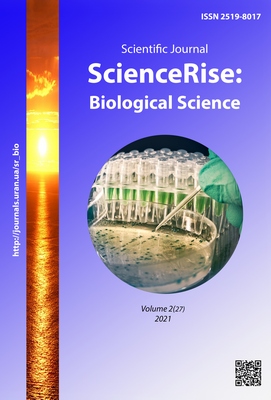Determination of toxicological characteristics of a complex antiemeric drug based on maduramycin and nicarbazine
DOI:
https://doi.org/10.15587/2519-8025.2021.235941Keywords:
toxicity, mice, rats, guinea pigs, maduramycin, nicarbazine, eimeriosisAbstract
The aim: to determine the parameters of acute toxicity of the preparative form of an antiemeric agent based on maduramycin and nicarbazine for white mice, white rats and guinea pigs with a single oral administration.
Materials and methods. Determination of acute toxicity of the formulation by oral administration was performed on 48 adult male mice, 48 adult nonlinear male rats, 48 adult male guinea pigs. To conduct an experiment on the principle analogues were formed seven experimental and one control group, 6 animal each. The dose of the formulation was calculated individually based on body weight values. It should be noted that the total volume of the emulsion of the formulation administered orally is not exceeded 1.0 cm3per 100 gram b. w.
Results. Toxicometric parameters of the formulation were calculated by the method of least squares for probit analysis of mortality curves. It was found that the LD50 of the preparative form of antiemeric agent for white mice for a single oral administration is 238.05±28.08 mg/kg, LD16 – 128.71 mg/kg, LD84 – 347.39 mg/kg, LD100 - 402, 06 mg/kg body weight, respectively.
LD50 of the preparative form of antiemeric agent for white rats with a single oral administration is 260.51±28.83 mg/kg, LD16 – 148.39 mg/kg, LD84 – 372.65 mg/kg, LD100 – 428.71 mg/kg body weight, respectively.
LD50 of the preparative form of antiemeric agent for guinea pigs for a single oral administration is 275±21.12 mg/kg, LD16 – 201.74 mg/kg, LD84 – 348.25 mg/kg, LD100 – 384.88 mg/kg body weight body respectively.
Conclusions. According to SOU 85.2-37-736: 2011 "Veterinary drugs. Determination of acute toxicity” preparative form of a complex antiemeric agent based on maduramycin and nicarbazine on the degree of toxicity can be attributed to moderately dangerous substances (3rd hazard class)
References
- Rybicki, M. J. (2020). Coccidiostats in treating coccidiosis. Żywność. Nauka. Technologia. Jakość, 2020, 27 (4 (125)), 127–137
- Chapman, H. D., Barta, J. R., Blake, D., Gruber, A., Jenkins, M., Smith, N. C. et. al. (2013). A Selective Review of Advances in Coccidiosis Research. Advances in Parasitology, 93–171. doi: http://doi.org/10.1016/b978-0-12-407705-8.00002-1
- Noack, S., Chapman, H. D., Selzer, P. M. (2019). Anticoccidial drugs of the livestock industry. Parasitology Research, 118 (7), 2009–2026. doi: http://doi.org/10.1007/s00436-019-06343-5
- Dorne, J. L. C. M., Fernández-Cruz, M. L., Bertelsen, U., Renshaw, D. W., Peltonen, K., Anadon, A. et. al. (2013). Risk assessment of coccidostatics during feed cross-contamination: Animal and human health aspects. Toxicology and Applied Pharmacology, 270 (3), 196–208. doi: http://doi.org/10.1016/j.taap.2010.12.014
- Radičević, T., Janković, S., Stefanović, S., Nikolić, D., Đinović-Stojanović, J., Spirić, D. (2017). Coccidiostats in unmedicated feedingstuffs for poultry. IOP Conference Series: Earth and Environmental Science, 85, 012080. doi: http://doi.org/10.1088/1755-1315/85/1/012080
- National Center for Biotechnology Information (2021). PubChem Compound Summary for CID 196129, Maduramicin. from https://pubchem.ncbi.nlm.nih.gov/compound/Maduramicin Last accessed: 21.06.2021
- Chen, X., Zhang, Y., Jiang, S., Huang, S. (2019). Maduramicin induces apoptosis through ROS-PP5-JNK pathway in skeletal myoblast cells and muscle tissue. Toxicology, 424, 152239. doi: http://doi.org/10.1016/j.tox.2019.152239
- Gao, X., Song, X., Zuo, R., Yang, D., Ji, C., Ji, H. et. al. (2020). Ionophore Toxin Maduramicin Produces Haff Disease-Like Rhabdomyolysis in a Mouse Model. International Journal of Environmental Research and Public Health, 17 (21), 7882. doi: http://doi.org/10.3390/ijerph17217882
- National Center for Biotechnology Information (2021). PubChem Compound Summary for CID 9507, Nicarbazin. https://pubchem.ncbi.nlm.nih.gov/compound/Nicarbazin Last accessed: 21.06.2021
- Filazi, A., Yurdakok-Dikmen, B.; Gupta, R., Srivastava, A., Lall, R. (Eds.) (2019). Regulatory Guidelines for Nutraceuticals and Dietary Supplements for Animals in Turkey. Nutraceuticals in Veterinary Medicine. Cham: Springer, 829–836. doi: http://doi.org/10.1007/978-3-030-04624-8_62
- OECD (1987). Test No. 401: Acute Oral Toxicity. OECD Guidelines for the Testing of Chemicals, Section 4. Paris: OECD Publishing. doi: http://doi.org/10.1787/9789264040113-en
- Prozorovskii, V. B. (2007). Statisticheskaia obrabotka rezul'tatov farmakologicheskih issledovanii. PFBN, 3-4.
- Pro zahist tvarin vіd zhorstokogo povodzhennia (2021). Zakon Ukraini No. 3447-IV. 21.02.2006. Available at: http://zakon5.rada.gov.ua/laws/show/3447-15
- SOU 85.2-37-736: 2011 "Veterinary drugs. Determination of acute toxicity" (2011). Kyiv: Ministry of Agrarian Policy, 16.
- Arisov, M. V., Urazaev, D. N., Kachanova, E. O., Pavlova, A. S. (2020). General principles of conducting preclinical toxicology studies of antiparasitic drugs for veterinary use. IOP Conference Series: Earth and Environmental Science, 548, 042042. doi: http://doi.org/10.1088/1755-1315/548/4/042042
- Sharma, N. (2005). Toxicity of maduramicin. Emergency Medicine Journal, 22 (12), 880–882. doi: http://doi.org/10.1136/emj.2004.020883
- Rumbeiha, W. K., Snider, D. B. (2014). Veterinary Toxicology. Encyclopedia of Toxicology. Academic Press, 915–928. doi: https://doi.org/10.1016/B978-0-12-386454-3.00444-9
- Kociumbas, І. Ia. (2005). Doklіnіchnі doslіdzhennia veterinarnih lіkars'kih zasobіv. Lvіv: Trіada plius, 134–147.
- Shlosberg, A., Perl, S., Harmelin, A., Hanji, V., Bellaiche, M., Bogin, E. et. al. (1997). Acute maduramicin toxicity in calves. Veterinary Record, 140 (25), 643–646. doi: http://doi.org/10.1136/vr.140.25.643
Downloads
Published
How to Cite
Issue
Section
License
Copyright (c) 2021 Roman Dotsenko, Yevheniia Vashchyk, Andriy Zakhariev, Andrii Zemlianskyi, Ekaterina Dotsenko, Nataliia Seliukova

This work is licensed under a Creative Commons Attribution 4.0 International License.
Our journal abides by the Creative Commons CC BY copyright rights and permissions for open access journals.
Authors, who are published in this journal, agree to the following conditions:
1. The authors reserve the right to authorship of the work and pass the first publication right of this work to the journal under the terms of a Creative Commons CC BY, which allows others to freely distribute the published research with the obligatory reference to the authors of the original work and the first publication of the work in this journal.
2. The authors have the right to conclude separate supplement agreements that relate to non-exclusive work distribution in the form in which it has been published by the journal (for example, to upload the work to the online storage of the journal or publish it as part of a monograph), provided that the reference to the first publication of the work in this journal is included.









